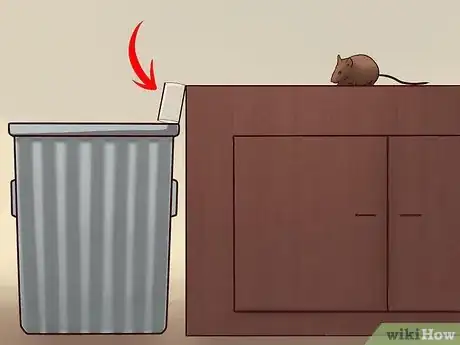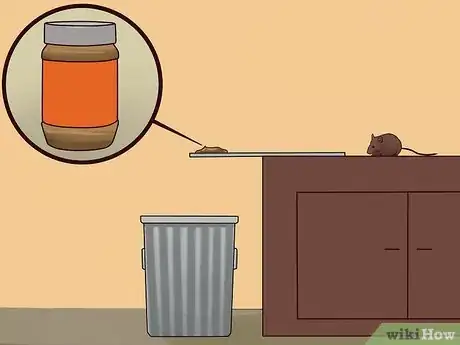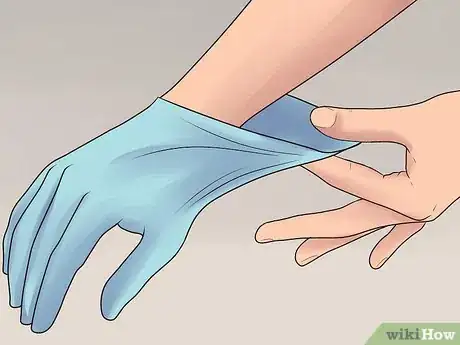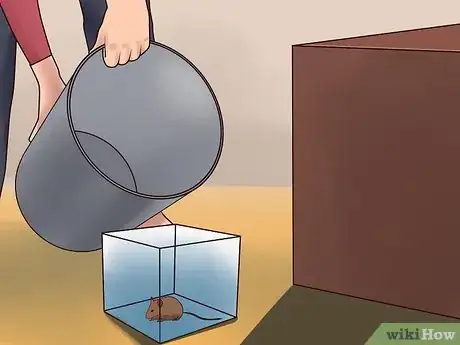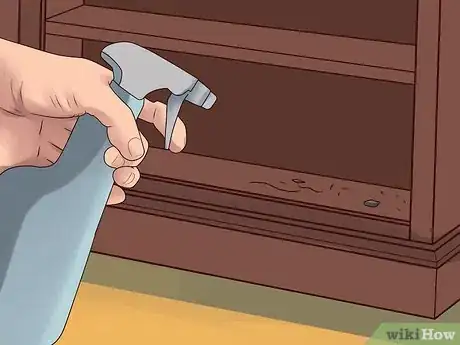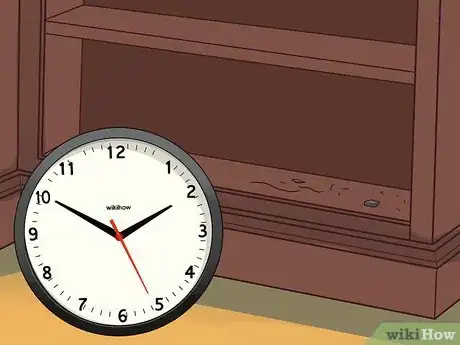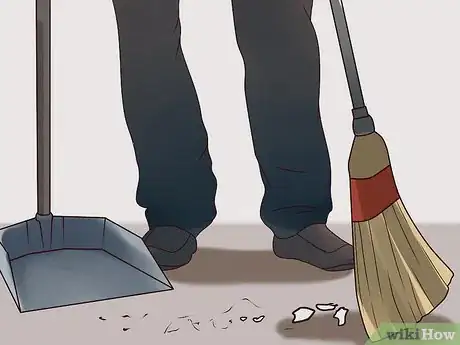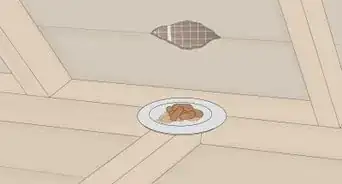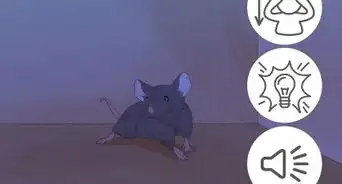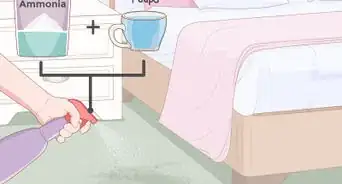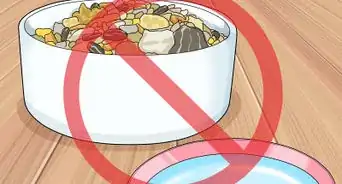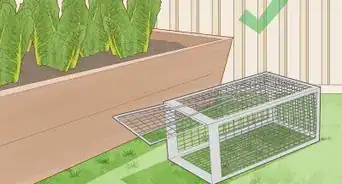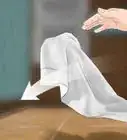This article was co-authored by Chris Parker. Chris Parker is the Founder of Parker Eco Pest Control, a sustainable pest control service in Seattle, Washington. With over seven years of experience, Chris specializes in Integrated Pest Management and doesn’t use any chemicals for pest removal. He offers removal services for ants, rodents, fleas, spiders, wasps, and more. Chris is a certified Commercial Pesticide Applicator in Washington State and received his bachelor’s from the University of Washington.
This article has been viewed 112,022 times.
Does the sound of scurrying mouse feet keep you awake at night? If so, it might be time to catch the culprit. If you're not looking to kill the mouse, learn how to prepare a trap, handle the mouse, and deter mice from returning.
Steps
Catching the Mouse
-
1Make a humane trap. Dab a little peanut butter on the inside of a very tall trash can (at least two feet high) and set the trash can next to a countertop that is taller than the trashcan. Crease an empty paper towel tube to create a flat tunnel and stick a little peanut butter on the inside at the end. Set this tube on the counter so that the end with the peanut butter hangs out over the trash can.
- If using a purchased live trap, be certain to follow the packaged instructions.
-
2Place the trap strategically. Put the trap in the room that you've noticed the most mouse activity. Once you've placed your trap, you'll want to avoid the space for a while so you don't accidentally drive the mouse away from the trap.
- If you don't have a counter to use, you can create a ramp by propping up a small board. Place a bit of peanut butter on the end of the ramp.The mouse will still be able to get in the trash can, but won't be able to get out.
Advertisement -
3Remove the mouse from the trash can while wearing gloves. Be sure to wear rubber, latex, or vinyl gloves since mice carry communicable diseases.[1]
- Get your cleaning supplies out, so that you can immediately disinfect the space once the mouse is contained. You'll need a mixture of bleach and water in a spray bottle.
-
4Transfer mouse to a container. The mouse shouldn't be able to get out, but must have ventilation to breathe.
- Do not put the mouse in cardboard, since it can easily chew through cardboard containers.
- Now you can thoroughly disinfect your trashcan and countertops with a mixture of bleach and water after you've removed the mouse. Throw away the cardboard tube.
-
5Remove the mouse from your house. Whatever you do, do not release the mouse right outside your home. Mice can find their way back into a warm environment nearby. Instead, drive the mouse at least five miles away and release it.[2]
- Try to relocate the mouse as soon as you can. The mouse will be contained for a shorter period of time, and you can get on with cleaning and disinfecting your home.
- You can increase its chance of survival if you release it near some kind of shelter. Avoid urban areas, where the mouse might simply return to another home, and wide-open spaces, where it can't find shelter from predators.
Deterring Mice From Returning
-
1Clean and disinfect areas of mouse contamination. Open windows for ventilation and spray any droppings with a mixture of bleach and water. The ratio of bleach should be one part to ten parts water.[3]
- Do not sweep or vacuum up mouse droppings or nesting materials.[4] These can kick up dust which could carry disease.
-
2Wait five minutes for bleach mixture to soak into the droppings. Then, use a paper towel to scoop up the droppings and throw away.
- Disinfect floors once you've cleaned the countertops by mopping with a bleach and water mixture.
- Remember to wash bedding in hot water and clean any upholstered furniture you think mice might have contaminated.
-
3Deter mice from coming back. In addition to keeping a clean home, check the seals on doors, windows, and access points to the outside. You can use whatever method you like to seal the gap, just be sure to fill all of them.[5]
- Do not use caulk or plastic fillers to seal gaps since mice can chew through them.[6]
- Sprinkle a few drops of peppermint oil on cotton balls and tuck them around your home. Since mice don't like the strong scent, they'll stay away.
-
4Clean your space. Mice are initially attracted to your cozy environment. If you clean out your house and make it less hospitable, mice will be less inclined to stay.
- Remove all clutter throughout your house. Don't leave out clothes, papers, or materials that mice could use to create nests.
- Don't forget to tidy up storage spaces, especially where paper goods or old clothes are kept.
-
5Clean up and seal away all food. Be incredibly through about this, as mice can make a meal out of almost anything. Wipe up crumbs from behind appliances and in cabinets.
- Do not leave food sitting out. This includes pet food. Be in the habit of sealing and storing your pet's food at night. This will make it harder for the mice to get comfortable.
- Food stored in a pantry should be completely closed. For example, if you've opened a sack of flour you should transfer it to a sealable container for longer storage.
Community Q&A
-
QuestionIs it possible to keep the mouse as a pet?
 Community AnswerIt is, but you'd be better off releasing it, as it's a wild animal, and you could get a domesticated mouse at a pet store.
Community AnswerIt is, but you'd be better off releasing it, as it's a wild animal, and you could get a domesticated mouse at a pet store. -
QuestionDoes baking soda help get rid of mice?
 Elijah FrancoCommunity AnswerYes, baking soda can repel mice. The most effective way to use baking soda to repel mice is to sprinkle a line around the perimeter of your house (outside). You will need to reapply the line after any rains. Luckily, baking soda is relatively inexpensive and can be purchased locally.
Elijah FrancoCommunity AnswerYes, baking soda can repel mice. The most effective way to use baking soda to repel mice is to sprinkle a line around the perimeter of your house (outside). You will need to reapply the line after any rains. Luckily, baking soda is relatively inexpensive and can be purchased locally. -
QuestionWill a mouse return after removal?
 Community AnswerIt's very unlikely, but you can take the mouse far away from your home to make sure.
Community AnswerIt's very unlikely, but you can take the mouse far away from your home to make sure.
Warning
References
- ↑ http://www.aaanimalcontrol.com/Professional-Trapper/howtotrapmice.html
- ↑ http://www.aaanimalcontrol.com/Professional-Trapper/howtotrapmice.html
- ↑ http://www.cdc.gov/rodents/cleaning/
- ↑ http://www.cdc.gov/rodents/cleaning/
- ↑ Chris Parker. Pest Control Specialist. Expert Interview. 21 April 2021.
- ↑ http://www.humanesociety.org/animals/mice/tips/solving_problems_mice.html
- ↑ http://www.wildlifeanimalcontrol.com/mousecatch.html
- ↑ http://www.humanesociety.org/animals/mice/tips/solving_problems_mice.html
About This Article
To catch a mouse without killing it, dab some peanut butter on the inside of a tall trash can, and set it next to a counter that’s taller than the trashcan. Then, crease an empty paper towel tube, and put some peanut butter on the inside end, and use it as a bridge between the counter and the can. Once the mouse falls in the can, you can remove it from your home. Once you've caught the mouse, prevent future mice by cleaning out any clutter, tidying up storage spaces where old clothes or papers are kept, and storing all food in completely closed containers so that mice are less attracted to your home. To learn how to deter mice from returning to your home, keep reading!
